A Reliability Assessment of the NCEP/FNL Reanalysis Data in Depicting Key Meteorological Factors on Clean Days and Polluted Days in Beijing
Abstract
1. Introduction
2. Data and Methods
2.1. NCEP/FNL Data
2.2. Observational Data
2.3. Methods
3. Results
3.1. Conventional Meteorological Factors
3.1.1. Temperature
3.1.2. Relative Humidity
3.1.3. Wind Speed
3.2. Diagnostic Physical Quantity
3.2.1. Temperature Inversion
3.2.2. Wind Shear
4. Conclusions and Discussion
Author Contributions
Funding
Institutional Review Board Statement
Informed Consent Statement
Data Availability Statement
Conflicts of Interest
References
- Guo, Z.; Guo, Q.; Chen, S.; Zhu, B.; Zhang, Y.; Yu, J.; Guo, Z. Study on pollution behavior and sulfate formation during the typical haze event in Nanjing with water soluble inorganic ions and sulfur isotopes. Atmos. Res. 2019, 217, 198–207. [Google Scholar] [CrossRef]
- Li, W.; Liu, X.; Zhang, Y.; Tan, Q.; Feng, M.; Song, M.; Hui, L.; Qu, Y.; An, J.; Gao, H. Insights into the phenomenon of an explosive growth and sharp decline in haze: A case study in Beijing. J. Environ. Sci. 2019, 84, 122–132. [Google Scholar] [CrossRef] [PubMed]
- Li, X.; Gao, Z.; Li, Y.; Gao, C.Y.; Ren, J.; Zhang, X. Meteorological conditions for severe foggy haze episodes over north China in 2016–2017 winter. Atmos. Environ. 2019, 199, 284–298. [Google Scholar] [CrossRef]
- Dong, Z.S.; Su, F.C.; Zhang, Z.Y.; Wang, S.B. Observation of chemical components of PM2.5 and secondary inorganic aerosol formation during haze and sandy haze days in Zhengzhou, China. J. Environ. Sci. China 2020, 88, 316–325. [Google Scholar] [CrossRef] [PubMed]
- Li, Q.; Wu, B.; Liu, J.; Zhang, H.; Cai, X.; Song, Y. Characteristics of the atmospheric boundary layer and its relation with PM2.5 during haze episodes in winter in the North China Plain. Atmos. Environ. 2020, 223, 117265. [Google Scholar] [CrossRef]
- He, J.; Gong, S.; Zhou, C.; Lu, S.; Wu, L.; Chen, Y.; Yu, Y.; Zhao, S.; Yu, L.; Yin, C. Analyses of winter circulation types and their impacts on haze pollution in Beijing. Atmos. Environ. 2018, 192, 94–103. [Google Scholar] [CrossRef]
- Xu, Q.; Wang, S.; Jiang, J.; Bhattarai, N.; Li, X.; Chang, X.; Qiu, X.; Zheng, M.; Hua, Y.; Hao, J. Nitrate dominates the chemical composition of PM2.5 during haze event in Beijing, China. Sci. Total Environ. 2019, 689, 1293–1303. [Google Scholar] [CrossRef]
- Ma, T.; Duan, F.; He, K.; Qin, Y.; Tong, D.; Geng, G.; Liu, X.; Li, H.; Yang, S.; Ye, S.; et al. Air pollution characteristics and their relationship with emissions and meteorology in the Yangtze River Delta region during 2014–2016. J. Environ. Sci. 2019, 83, 8–20. [Google Scholar] [CrossRef] [PubMed]
- Yang, S.; Duan, F.; Ma, Y.; Li, H.; Ma, T.; Zhu, L.; Huang, T.; Kimoto, T.; He, K. Mixed and intensive haze pollution during the transition period between autumn and winter in Beijing, China. Sci. Total Environ. 2020, 711, 134745. [Google Scholar] [CrossRef]
- Zhou, S.Z.; Yang, L.X.; Gao, R.; Wang, X.F.; Gao, X.M.; Nie, W.; Xu, P.J.; Zhang, Q.Z.; Wang, W.X. A comparison study of carbonaceous aerosols in a typical North China Plain urban atmosphere: Seasonal variability, sources and implications to haze formation. Atmos. Environ. 2017, 149, 95–103. [Google Scholar] [CrossRef]
- Liu, C.; Hua, C.; Zhang, H.; Zhang, B.; Wang, G.; Zhu, W.; Xu, R. A severe fog-haze episode in Beijing-Tianjin-Hebei region: Characteristics, sources and impacts of boundary layer structure. Atmos. Pollut. Res. 2019, 10, 1190–1202. [Google Scholar] [CrossRef]
- Sun, J.; Gong, J.; Zhou, J.; Liu, J.; Liang, J. Analysis of PM2.5 pollution episodes in Beijing from 2014 to 2017: Classification, interannual variations and associations with meteorological features. Atmos. Environ. 2019, 213, 384–394. [Google Scholar] [CrossRef]
- Wang, S.B.; Yin, S.S.; Zhang, R.Q.; Yang, L.M.; Zhao, Q.Y.; Zhang, L.S.; Yan, Q.S.; Jiang, N.; Tang, X.Y. Insight into the formation of secondary inorganic aerosol based on high-time-resolution data during haze episodes and snowfall periods in Zhengzhou, China. Sci. Total Environ. 2019, 660, 47–56. [Google Scholar] [CrossRef] [PubMed]
- Zhang, H.; Cheng, S.; Yao, S.; Wang, X.; Zhang, J. Multiple perspectives for modeling regional PM2.5 transport across cities in the Beijing–Tianjin–Hebei region during haze episodes. Atmos. Environ. 2019, 212, 22–35. [Google Scholar] [CrossRef]
- Liu, D.Y.; Yan, W.L.; Kang, Z.M.; Liu, A.N.; Zhu, Y. Boundary-layer features and regional transport process of an extreme haze pollution event in Nanjing, China. Atmos. Pollut. Res. 2018, 9, 1088–1099. [Google Scholar] [CrossRef]
- Shi, P.; Zhang, G.; Kong, F.; Chen, D.; Azorin-Molina, C.; Guijarro, J.A. Variability of winter haze over the Beijing-Tianjin-Hebei region tied to wind speed in the lower troposphere and particulate sources. Atmos. Res. 2019, 215, 1–11. [Google Scholar] [CrossRef]
- Deng, H.; Tan, H.B.; Li, F.; Cai, M.F.; Chan, P.W.; Xu, H.B.; Huang, X.Y.; Wu, D. Impact of relative humidity on visibility degradation during a haze event: A case study. Sci. Total Environ. 2016, 569–570, 1149–1158. [Google Scholar] [CrossRef] [PubMed]
- Liu, W.; Han, Y.; Li, J.; Tian, X.; Liu, Y. Factors affecting relative humidity and its relationship with the long-term variation of fog-haze events in the Yangtze River Delta. Atmos. Environ. 2018, 193, 242–250. [Google Scholar] [CrossRef]
- Wu, W.; Zha, Y.; Zhang, J.; Gao, J.; He, J. A temperature inversion-induced air pollution process as analyzed from Mie LiDAR data. Sci. Total Environ. 2014, 479–480, 102–108. [Google Scholar] [CrossRef]
- Zang, Z.; Wang, W.; You, W.; Li, Y.; Ye, F.; Wang, C. Estimating ground-level PM2.5 concentrations in Beijing, China using aerosol optical depth and parameters of the temperature inversion layer. Sci. Total Environ. 2017, 575, 1219–1227. [Google Scholar] [CrossRef] [PubMed]
- Xu, T.; Song, Y.; Liu, M.; Cai, X.; Zhang, H.; Guo, J.; Zhu, T. Temperature inversions in severe polluted days derived from radiosonde data in North China from 2011 to 2016. Sci. Total Environ. 2019, 647, 1011–1020. [Google Scholar] [CrossRef]
- Bei, N.; Xiao, B.; Meng, N.; Feng, T. Critical role of meteorological conditions in a persistent haze episode in the Guanzhong basin, China. Sci. Total Environ. 2016, 550, 273–284. [Google Scholar] [CrossRef] [PubMed]
- Zhou, Y.K.; Zhu, B.; Han, Z.W.; Pan, C.; Guo, T.; Wei, J.S.; Liu, D.Y. Analysis of visibility characteristics and connecting factors over the Yangtze River Delta Region during winter time. China Environ. Sci. 2016, 36, 660–669. (In Chinese) [Google Scholar]
- Lu, M.M.; Tang, X.; Wang, Z.F.; Alex, G.; Liang, S.W.; Hu, K.; Wu, L.; Wu, H.J.; Huang, Z.; Shen, L.J. Source tagging modeling study of heavy haze episodes under complex regional transport processes over Wuhan megacity, Central China. Environ. Pollut. 2017, 231, 612–621. [Google Scholar] [CrossRef] [PubMed]
- Bei, N.F.; Li XPTie, X.X.; Zhao, L.N.; Wu, J.R.; Li, X.; Liu, L.; Shen, Z.X.; Li, G.H. Impact of synoptic patterns and meteorological elements on the wintertime haze in the Beijing-Tianjin-Hebei region, China from 2013 to 2017. Sci. Total Environ. 2020, 704, 1–10. [Google Scholar] [CrossRef] [PubMed]
- Zhang, L.; Wang, T.; Lv, M.Y.; Zhang, Q. On the severe haze in Beijing during January 2013: Unraveling the effects of meteorological anomalies with WRF-Chem. Atmos. Environ. 2015, 104, 11–21. [Google Scholar] [CrossRef]
- Li, J.; Du, H.; Wang, Z.; Sun, Y.; Yang, W.; Li, J.; Tang, X.; Fu, P. Rapid formation of a severe regional winter haze episode over a mega-city cluster on the North China Plain. Environ. Pollut. 2017, 223, 605–615. [Google Scholar] [CrossRef] [PubMed]
- Lee, Y.; Yang, X.; Wenig, M. Transport of dusts from East Asian and non-East Asian sources to Hong Kong during dust storm related events 1996–2007. Atmos. Environ. 2010, 44, 3728–3738. [Google Scholar] [CrossRef]
- Li, T.; Deng, X.; Li, Y.; Song, Y.; Li, L.; Tan, H.; Wang, C. Transport paths and vertical exchange characteristics of haze pollution in Southern China. Sci. Total Environ. 2018, 625, 1074–1087. [Google Scholar] [CrossRef]
- Kanamitsu, M.; Ebisuzaki, W.; Woollen, J.; Yang, S.-K.; Hnilo, J.J.; Fiorino, M.; Potter, G.L. NCEP–DOE AMIPII Reanalyzed (R-2). Br. Am. Meteor. Soc. 2002, 83, 1631–1643. [Google Scholar] [CrossRef]
- Fu, J.J.; Li, S. Intercomparison of the South Asian high in NCEP1, NCEP2, and ERA-40 reanalyses and in station observations. Atmos. Ocean. Sci. Lett. 2012, 5, 189–194. [Google Scholar]
- Carvalho, D.; Rocha, A.; Gómez-Gesteira, M.; Santos, C.S. Comparison of reanalyzed, analyzed, satellite-retrieved and NWP modelled winds with buoy data along the Iberian Peninsula coast. Remote Sens. Environ. 2014, 152, 480–492. [Google Scholar] [CrossRef]
- Stopa, J.E.; Cheung, K.F. Intercomparison of wind and wave data from the ECMWF Reanalysis Interim and the NCEP Climate Forecast System Reanalysis. Ocean. Model. 2014, 75, 65–83. [Google Scholar] [CrossRef]
- Dhana, L.D.; Satyanarayana, A.N.V. Influence of atmospheric rivers in the occurrence of devastating flood associated with extreme precipitation events over Chennai using different reanalysis data sets. Atmos. Res. 2019, 215, 12–36. [Google Scholar] [CrossRef]
- Huai, B.; Wang, Y.; Ding, M.; Zhang, J.; Dong, X. An assessment of recent global atmospheric reanalyses for Antarctic near surface air temperature. Atmos. Res. 2019, 226, 181–191. [Google Scholar] [CrossRef]
- Santer, B.D.; Wigley, T.M.L.; Gaffen, D.J.; Bengtsson, L.; Doutriaux, C.; Boyle, J.S.; Esch, M.; Hnilo, J.J.; Jones, P.D.; Meehl, G.A.; et al. Interpreting Differential Temperature Trends at the Surface and in the Lower Troposphere. Science 2000, 287, 1227–1232. [Google Scholar] [CrossRef] [PubMed][Green Version]
- Zolina, O.; Kapala, A.; Simmer, C.; Gulev, S.K. Analysis of extreme precipitation over Europe from different reanalyses: A comparative assessment. Glob. Planet. Chang. 2004, 44, 129–161. [Google Scholar] [CrossRef]
- Xie, A.; Ren, J.; Qin, X.; Kang, S. Pressure and temperature feasibility of NCEP/NCAR reanalysis data at Mt. Everest. J. Mt. Sci. 2008, 5, 32–37. [Google Scholar] [CrossRef]
- Tabata, Y.; Hashiguchi, H.; Yamamoto, M.K.; Yamamoto, M.; Yamanaka, M.D.; Mori, S.; Syamsudin, F.; Manik, T. Lower trop-ospheric horizontal wind over Indonesia: A comparison of wind profiler network observations with global reanalyses. J. Atmos. Sol. Terr. Phys. 2011, 73, 986–995. [Google Scholar] [CrossRef]
- Wang, Y.; Zhou, D.; Bunde, A.; Havlin, S. Testing reanalyzed data sets in Antarctica: Trends, persistence properties, and trend significance. J. Geophys. Res. Atmos. 2016, 121, 12839–12855. [Google Scholar] [CrossRef]
- Cheng, H.H.; Wang, Y.B.; Wen, B.; Wu, S.; Zhi, M.L.; Zhao, L. Confidence analysis of rainy and snowy weather diagnosis in Kelan, Shanxi province based on NCEP/FNL data. J. Meteorol. Environ. 2019, 35, 23–31. (In Chinese) [Google Scholar]
- Brunke, M.A.; Stegall, S.T.; Zeng, X. A climatology of tropospheric humidity inversions in five reanalyses. Atmos. Res. 2015, 153, 165–187. [Google Scholar] [CrossRef]
- Zhao, T.B.; Fu, C.B. Preliminary Comparison and Analysis between ERA-40, NCEP-2 Reanalysis and Observations over China. Clim. Environ. Res. 2006, 11, 14–32. (In Chinese) [Google Scholar]
- Malmusi, S.; Boccolari, M. Upper and middle precipitable water calculated from METEOSAT-8/-9 tropospheric humidity and NCEP/NCAR temperatures. Atmos. Res. 2010, 95, 8–18. [Google Scholar] [CrossRef]
- Wei, Y.H.; Wang, Y.C.; Zhu, L.L.; Lin, X.M.; Yang, Y. Confidence and characteristics of short-duration heavy rainfall environment parameters based on merging data in Tianjin. Desert Oasis Meteorol. 2020, 14, 84–91. (In Chinese) [Google Scholar]
- Xu, Y.; Ding, Y.H.; Zhao, Z.C. Confidence Analysis of NCEP/NCAR 50-year Global Reanalyzed Data in Climate Change Research in China. J. Appl. Meteorol. Sci. 2001, 12, 337–347. (In Chinese) [Google Scholar]
- Zhou, S.W.; Zhang, R.H. Comparison of NCEP/NCAR reanalyzed data and radiosonde data about temperature and geopotential height of upper air over the Tibetan Plateau. Clim. Environ. Res. 2009, 14, 284–292. (In Chinese) [Google Scholar]
- You, Q.L.; Klaus, F.; Min JZKang, S.C.; Zhu, X.H.; Ren, G.Y.; Meng, X.H. Can temperature extremes in china be calculated from reanalysis? Glob. Planet. Chang. 2013, 111, 268–279. [Google Scholar] [CrossRef]
- Peng, Y.; Wang, H.; Zhang, X.; Zhao, T.; Jiang, T.; Che, H.; Zhang, W.; Liu, Z. Impacts of PBL schemes on PM2.5 simulation and their responses to aerosol-radiation feedback in GRAPES_CUACE model during severe haze episodes in Jing-Jin-Ji, China. Atmos. Res. 2021, 248, 105268. [Google Scholar] [CrossRef]
- Zhang, M.; Jin, S.K.; Ma, Y.Y.; Fan, R.N.; Wang, L.C.; Gong, W.; Liu, B.M. Haze events at different levels in winters: A comprehensive study of meteorological factors, Aerosol characteristics and direct radiative forcing in megacities of north and central China. Atmos. Environ. 2021, 245, 118056. [Google Scholar] [CrossRef]
- Ren, Y.; Zhang, H.; Wei, W.; Wu, B.; Liu, J.; Cai, X.; Song, Y. Comparison of the turbulence structure during light and heavy haze pollution episodes. Atmos. Res. 2019, 230, 104645. [Google Scholar] [CrossRef]
- Ren, Y.; Zhang, H.S.; Zhang, X.Y.; Li, Q.H.; Cai, X.H.; Song, Y.; Kang, L.; Zhu, T. Temporal and spatial characteristics of turbulent transfer and diffusion coefficient of PM2.5. Sci. Total Environ. 2021, 146804. [Google Scholar] [CrossRef]
- Yuan, S.; Cheng, H.; Wang, D.Y.; Wu, D.C.; Zhou, J. Comparative analysis on meteorological parameters of sounding data and model-generated sounding data. J. Meteorol. Sci. 2012, 32, 62–67. (In Chinese) [Google Scholar]
- Han, B.; Wang, Y.; Zhang, R.; Yang, W.; Ma, Z.; Geng, W.; Bai, Z. Comparative statistical models for estimating potential roles of relative humidity and temperature on the concentrations of secondary inorganic aerosol: Statistical insights on air pollution episodes at Beijing during January 2013. Atmos. Environ. 2019, 212, 11–21. [Google Scholar] [CrossRef]
- Peng, Y.; Wang, H.; Hou, M.; Jiang, T.; Zhang, M.; Zhao, T.; Che, H. Improved method of visibility parameterization focusing on high humidity and aerosol concentrations during fog–haze events: Application in the GRAPES_CAUCE model in Jing-Jin-Ji, China. Atmos. Environ. 2020, 222, 117139. [Google Scholar] [CrossRef]
- Wang, H.; Li, J.; Peng, Y.; Zhang, M.; Che, H.; Zhang, X. The impacts of the meteorology features on PM2.5 levels during a severe haze episode in central-east China. Atmos. Environ. 2019, 197, 177–189. [Google Scholar] [CrossRef]
- Dong, L.P.; Wu, L. Comparing wind profiler data with NCEP reanalyzed data and analyzing. Electron. Des. Eng. 2014, 22, 156–161. (In Chinese) [Google Scholar]
- Zhong, J.T.; Zhang, X.Y.; Wang, Y.Q. Relatively weak meteorological feedback effect on PM2.5 mass change in Winter 2017/18 in the Beijing area: Observational evidence and machine-learning estimations. Sci. Total Environ. 2019, 664, 140–147. [Google Scholar] [CrossRef] [PubMed]
- Zhang, Q.; Ma, Q.; Zhao, B.; Liu, X.; Wang, Y.; Jia, B.; Zhang, X. Winter haze over North China Plain from 2009 to 2016: Influence of emission and meteorology. Environ. Pollut. 2018, 242, 1308–1318. [Google Scholar] [CrossRef]
- Li, Y.; Xue, Y.; Guang, J.; Gerrit, D.L.; Richard, S.; She, L.; Fan, C.; Xie, Y.Q.; Chen, G.L. Spatial and temporal distribution characteristics of haze days and associated factors in China from 1973 to 2017. Atmos. Environ. 2019, 214, 1–14. [Google Scholar] [CrossRef]
- Xu, F.; Zheng, Y.Y.; Xiao, H.; Mu, X.Y. Mesoscale Characteristics of a Severe Hail Event over the Area along Yangtze River in Jiangsu. Meteorol. Mon. 2016, 42, 567–577. (In Chinese) [Google Scholar]
- Feng, W.Y.; Wang, M.H.; Zhang, Y.; Dai, X.L.; Liu, X.H.; Xu, Y.Y. Intraseasonal variation and future projection of atmospheric diffusion conditions conductive to extreme haze formation over eastern China. Atmos. Ocean. Sci. Lett. 2020, 13, 346–355. [Google Scholar] [CrossRef]
- Sun, Y.; Zhang, B.; Yan, W.L.; Chen, Q.; Zhao, K. Analysis of a heavy haze event in Nanjing and its surrounding area. Plateau Meteorol. 2010, 29, 794–800. (In Chinese) [Google Scholar]
- Cheng, H.H.; Wen, B.; Wang, Y.B.; Xu, Y. Confidence analysis of NCEP/FNL FNL data on strong convective weather. Meteorol. Environ. Sci. 2018, 41, 1–10. [Google Scholar]

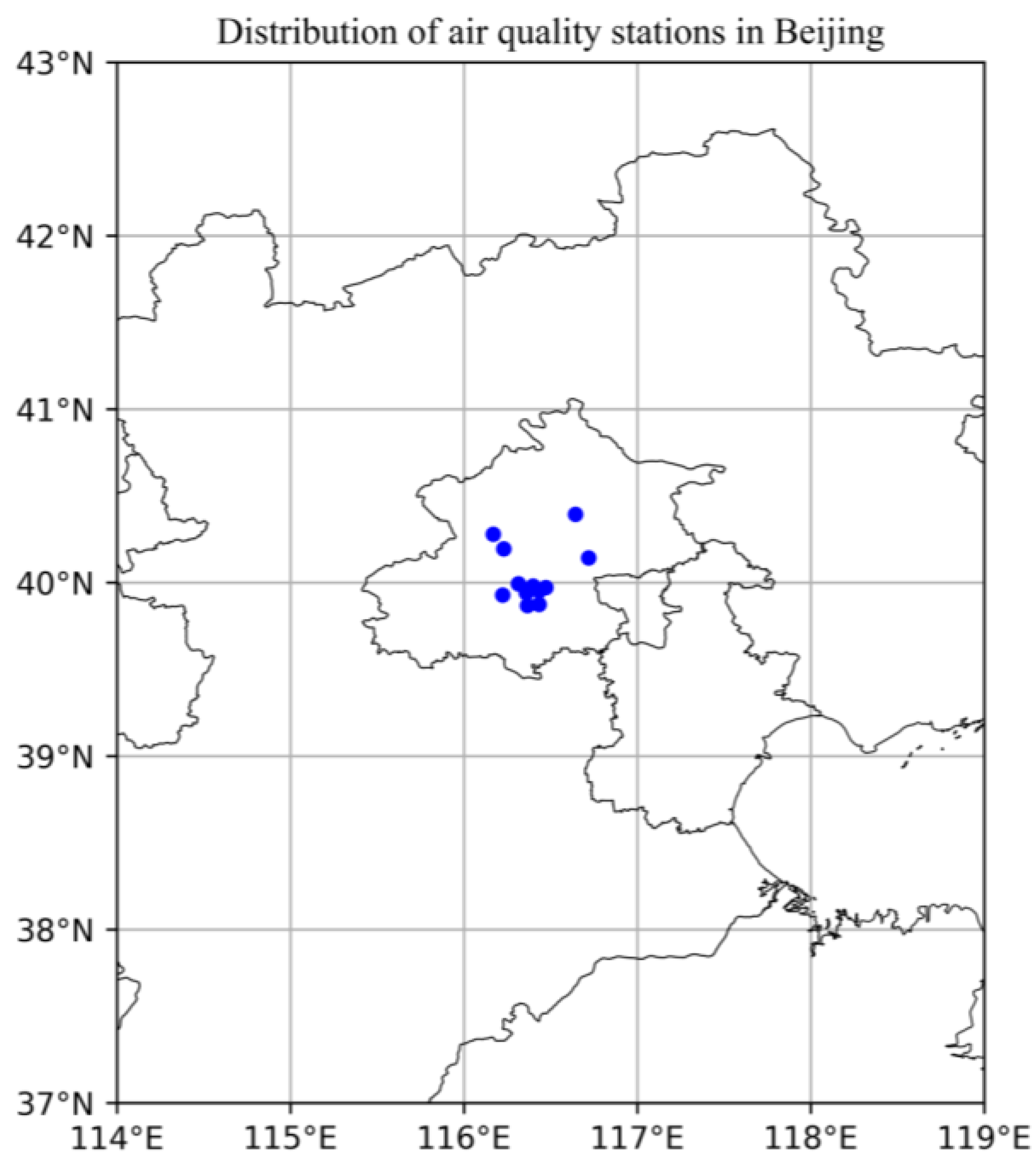


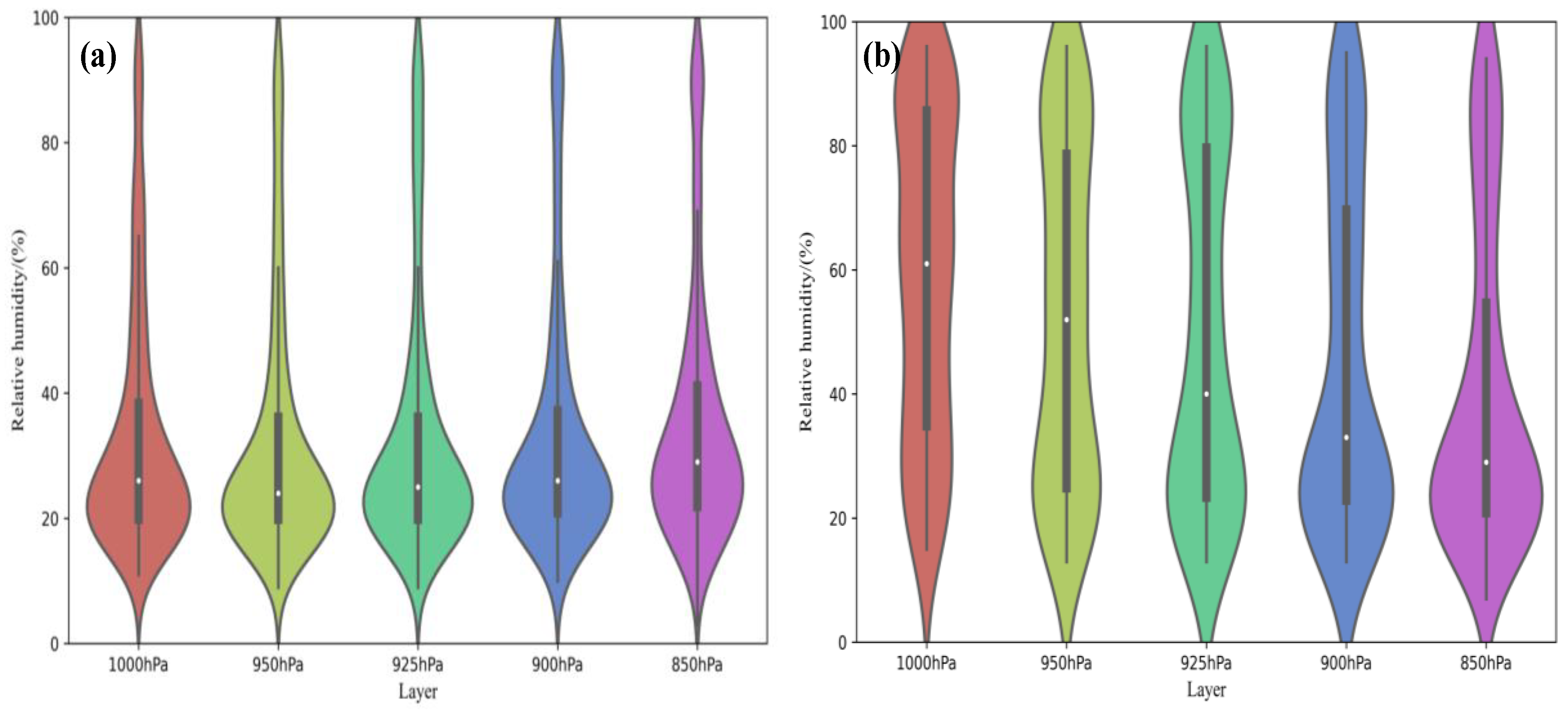
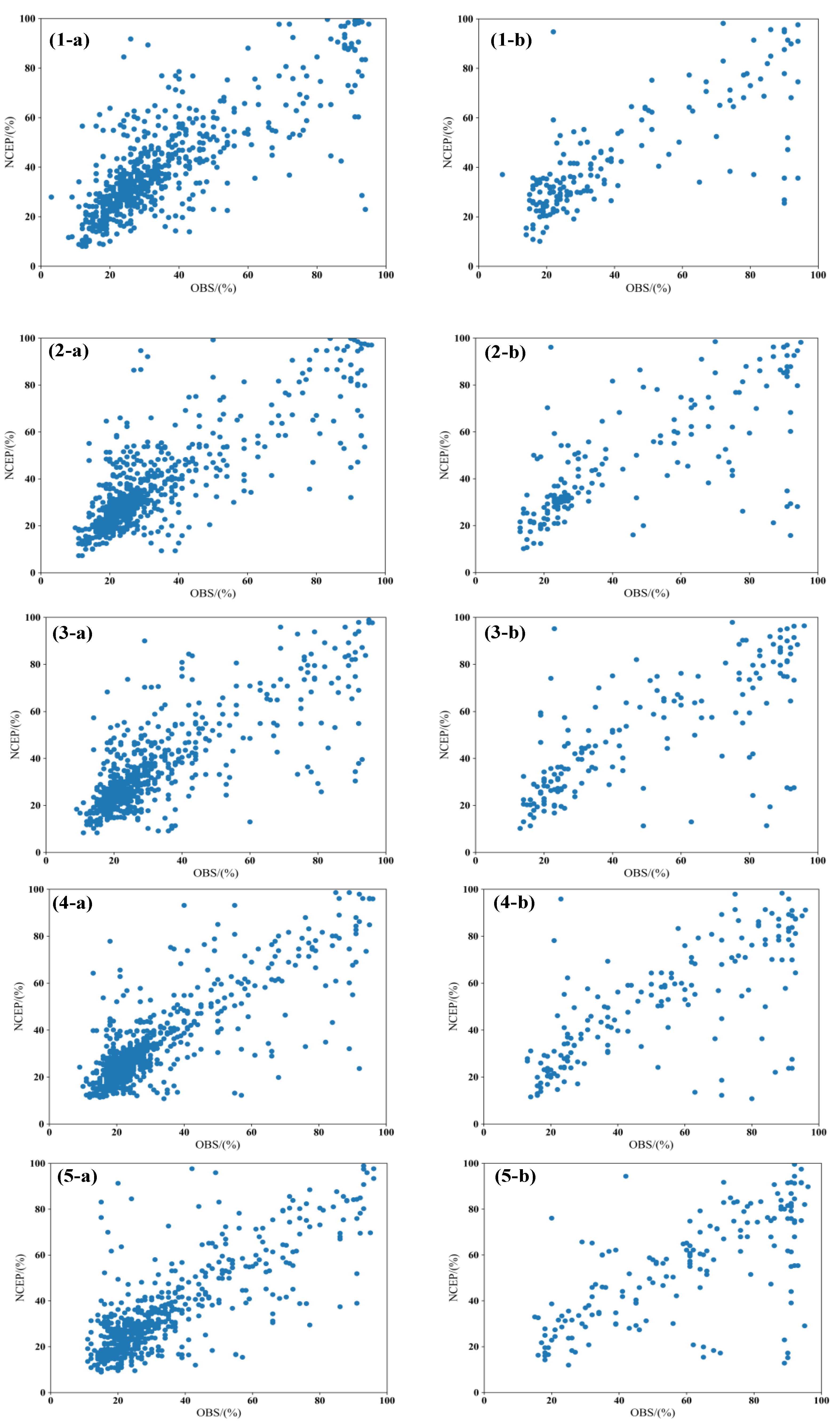

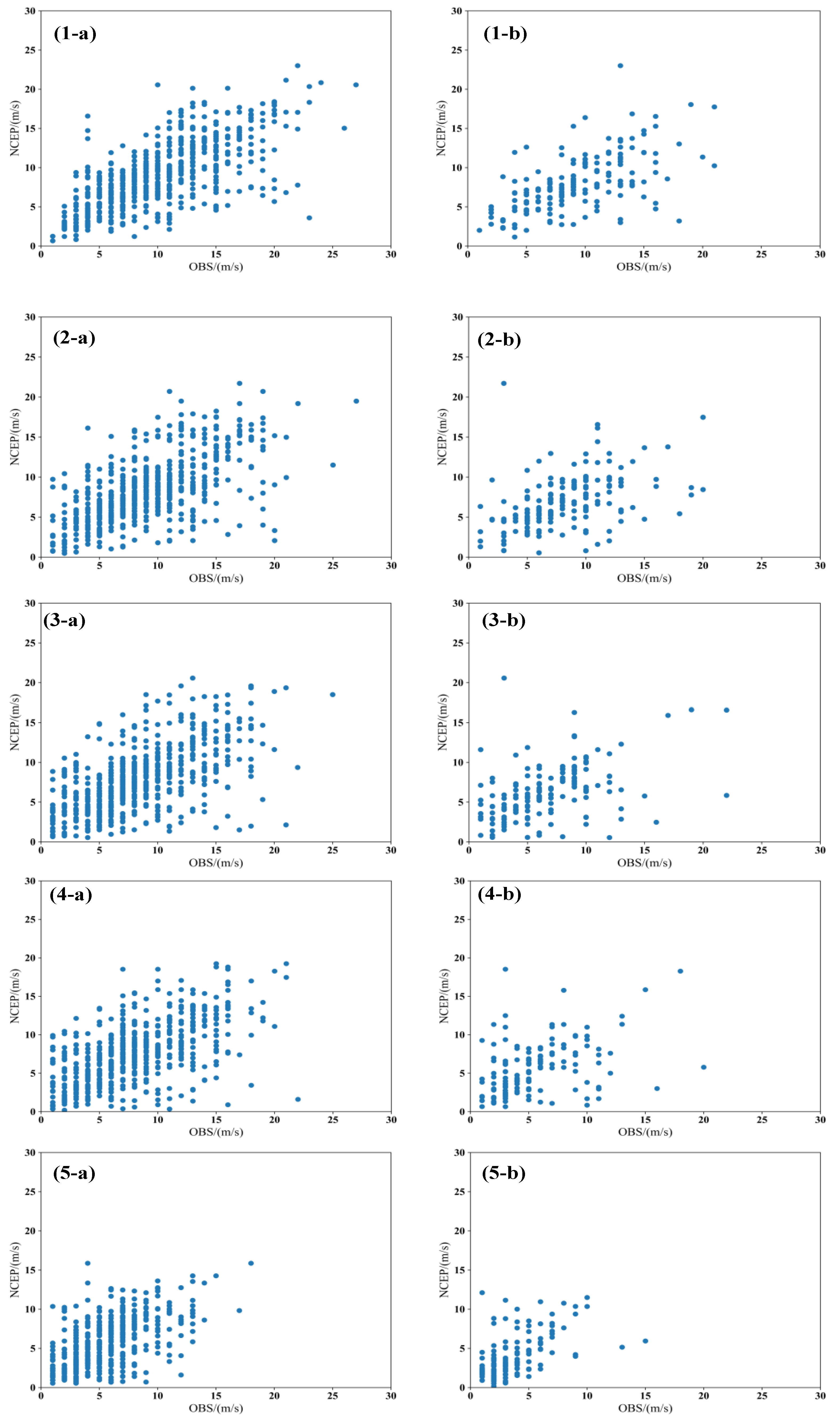
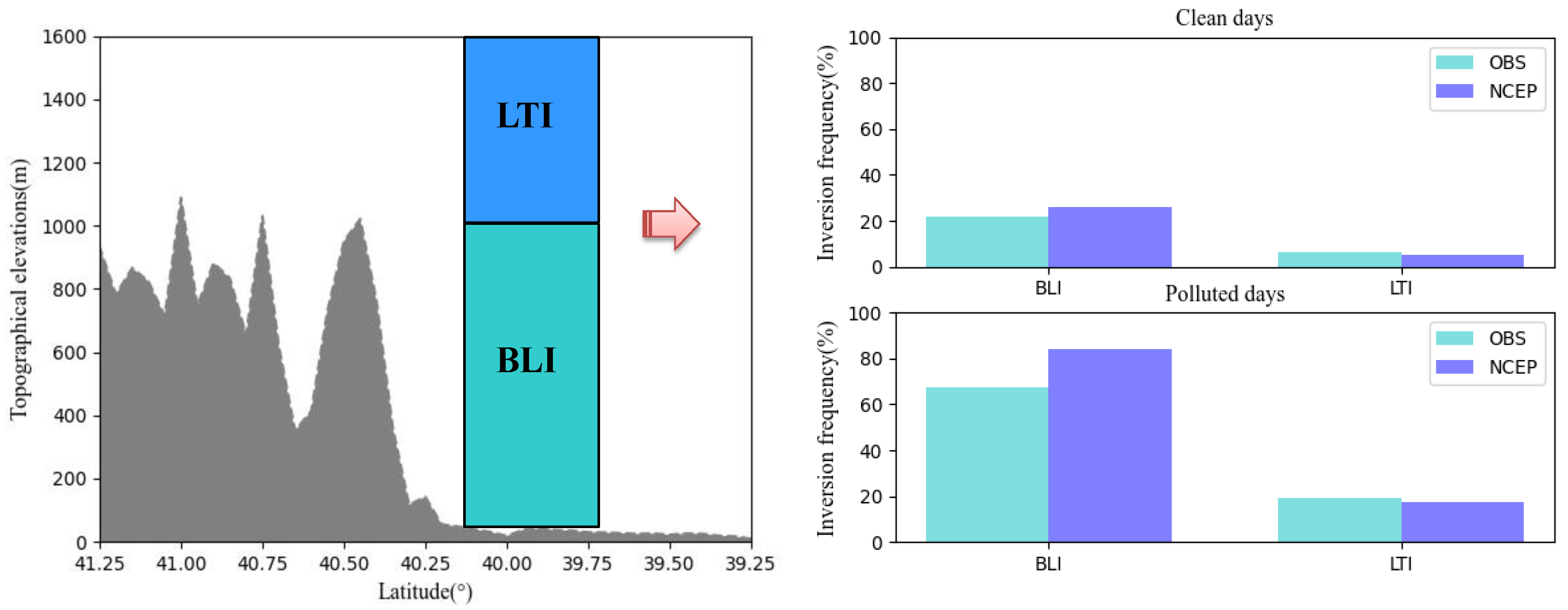
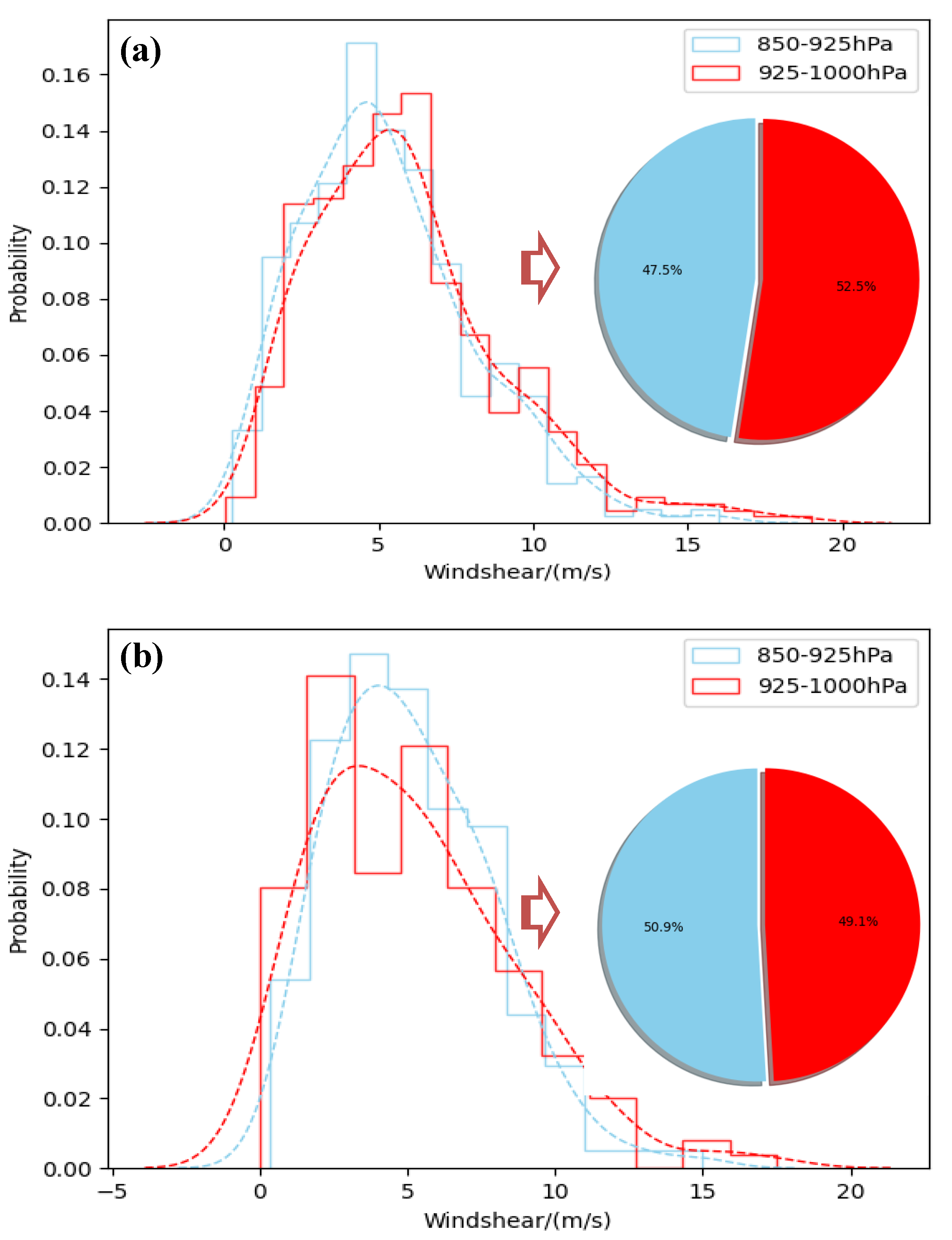
| Station | Station Code | Latitude (°) | Longitude (°) | Numbers of Clean Days (n) | Numbers of Polluted Days (n) |
|---|---|---|---|---|---|
| Beijing | 54511 | 39.80 | 116.47 | 632 | 171 |
| Number | Error Metrics | Equation |
|---|---|---|
| 1 | BIAS | |
| 2 | RMSE | |
| 3 |
| Type of Days | Error Metrics | Layer (hPa) | ||||
|---|---|---|---|---|---|---|
| 1000 | 950 | 925 | 900 | 850 | ||
| clean days | BIAS | −0.75 | −0.69 | −0.31 | −0.23 | −0.15 |
| RMSE | 3.21 | 2.50 | 2.53 | 2.31 | 2.39 | |
| 0.90 | 0.94 | 0.94 | 0.95 | 0.95 | ||
| polluted days | BIAS | −0.81 | −0.70 | −0.50 | −0.47 | −0.45 |
| RMSE | 3.48 | 2.51 | 2.51 | 2.38 | 2.46 | |
| 0.84 | 0.92 | 0.93 | 0.93 | 0.92 | ||
| Type of Days | Error Metrics | Layer (hPa) | ||||
|---|---|---|---|---|---|---|
| 1000 | 950 | 925 | 900 | 850 | ||
| clean days | BIAS | 0.74 | 2.45 | 2.98 | 3.62 | 3.91 |
| RMSE | 12.5 | 12.4 | 13.5 | 13.4 | 13.8 | |
| 0.79 | 0.79 | 0.78 | 0.79 | 0.78 | ||
| polluted days | BIAS | −5.12 | −0.90 | 0.89 | 1.94 | 2.85 |
| RMSE | 20.67 | 19.5 | 19.7 | 19.2 | 16.6 | |
| 0.67 | 0.71 | 0.72 | 0.71 | 0.75 | ||
| Type of Days | Error Metrics | Layer (hPa) | ||||
|---|---|---|---|---|---|---|
| 1000 | 950 | 925 | 900 | 850 | ||
| clean days | BIAS | 0.19 | −0.37 | −0.63 | −0.78 | −1.04 |
| RMSE | 2.91 | 3.79 | 3.93 | 3.84 | 3.71 | |
| 0.57 | 0.59 | 0.59 | 0.62 | 0.69 | ||
| polluted days | BIAS | 0.21 | −0.01 | −0.41 | −1.19 | −1.28 |
| RMSE | 2.60 | 3.89 | 3.85 | 4.02 | 3.83 | |
| 0.53 | 0.40 | 0.44 | 0.48 | 0.58 | ||
| Type of Days | Data | Layer (hPa) | Accumulated Temperature Inversion in All Layers | |||
|---|---|---|---|---|---|---|
| 950–1000 | 925–950 | 900–925 | 850–900 | |||
| clean days | OBS | 1.58 | 1.13 | 0.94 | 1.53 | 1.71 |
| NCEP | 1.42 | 0.86 | 0.60 | 0.91 | 1.61 | |
| polluted days | OBS | 2.19 | 1.66 | 1.57 | 2.06 | 2.67 |
| NCEP | 1.63 | 0.90 | 0.80 | 1.44 | 2.12 | |
| Type of Days | Data | Layer (hPa) | |
|---|---|---|---|
| 850–925 | 925–1000 | ||
| clean days | OBS | 5.55 | 5.85 |
| NCEP | 4.47 | 5.69 | |
| polluted days | OBS | 5.18 | 5.21 |
| NCEP | 4.28 | 4.81 | |
Publisher’s Note: MDPI stays neutral with regard to jurisdictional claims in published maps and institutional affiliations. |
© 2021 by the authors. Licensee MDPI, Basel, Switzerland. This article is an open access article distributed under the terms and conditions of the Creative Commons Attribution (CC BY) license (https://creativecommons.org/licenses/by/4.0/).
Share and Cite
Liu, C.; Guo, J.; Zhang, B.; Zhang, H.; Guan, P.; Xu, R. A Reliability Assessment of the NCEP/FNL Reanalysis Data in Depicting Key Meteorological Factors on Clean Days and Polluted Days in Beijing. Atmosphere 2021, 12, 481. https://doi.org/10.3390/atmos12040481
Liu C, Guo J, Zhang B, Zhang H, Guan P, Xu R. A Reliability Assessment of the NCEP/FNL Reanalysis Data in Depicting Key Meteorological Factors on Clean Days and Polluted Days in Beijing. Atmosphere. 2021; 12(4):481. https://doi.org/10.3390/atmos12040481
Chicago/Turabian StyleLiu, Chao, Jianping Guo, Bihui Zhang, Hengde Zhang, Panbo Guan, and Ran Xu. 2021. "A Reliability Assessment of the NCEP/FNL Reanalysis Data in Depicting Key Meteorological Factors on Clean Days and Polluted Days in Beijing" Atmosphere 12, no. 4: 481. https://doi.org/10.3390/atmos12040481
APA StyleLiu, C., Guo, J., Zhang, B., Zhang, H., Guan, P., & Xu, R. (2021). A Reliability Assessment of the NCEP/FNL Reanalysis Data in Depicting Key Meteorological Factors on Clean Days and Polluted Days in Beijing. Atmosphere, 12(4), 481. https://doi.org/10.3390/atmos12040481








